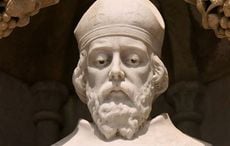Irish revolution hero set to be first woman to be honored with a statue on Ireland’s most famous street to celebrate the suffragettes on the centenary of women getting the vote.
Irish revolution hero Countess Constance Markievicz is set to be the first woman to be honored with a statue on Ireland’s most famous street, if a council vote goes her way next month.
Dublin City councilors want to erect a statue of the countess on O’Connell Street to celebrate the suffragettes on the centenary of women getting the vote.
Councilors will vote next month on plans that would make Markievicz the first woman, as well as the first of the 1916 rebels, to be commemorated on the capital’s main thoroughfare.
Independent Councilor Vincent Jackson, who proposed the motion to erect the statue, said, “She was a powerful woman for advocating the rights of women. She is sufficiently significant within Irish history to warrant a place on O’Connell Street too.”
Read more: Trinity’s online exhibition marks 100th anniversary of Irish women gaining the vote
Markievicz already has a bust in St. Stephen’s Green and a statue on Tara Street in Dublin.
She was second in command of the battalion that fought in St. Stephen’s Green during the 1916 rebellion and was sentenced to death for that activity. The sentence was commuted, largely because of her gender, and soon after her release from prison she became the first woman elected to the British Parliament, in 1918.
Markievicz abstained from Westminster and then became the second woman in the world to hold a cabinet position, when she joined the first Dail as minister of labor in 1919. An estimated 300,000 people attended her state funeral when she died in 1927.
Although born into a wealthy, aristocratic family based at Lissadell, Co. Sligo, Markievicz decided to dedicate her life to fighting for equality. She gave away her own money to the poor and died penniless in a public hospital.
Monuments currently standing in O’Connell Street, all celebrating men, include from north to south 19th century political leader Daniel O’Connell, Westminster MP William Smith O’Brien who was convicted for sedition for his part in the Young Irelander rebellion of 1848, Freeman’s Journal proprietor Sir John Gray, Trade Union leader James Larkin who organized the workers in the Dublin lockout of 1913, and Nationalist Charles Stewart Parnell who was one of the most powerful figures in the British House of Commons in the 1880s.
Read more: Do you know who’s in your family’s Glasnevin Cemetery plot? I didn’t




Comments